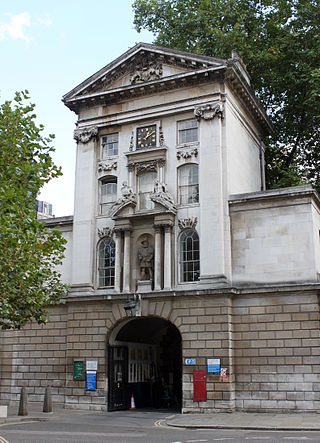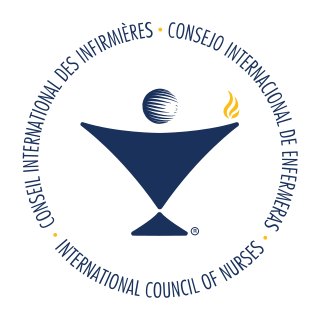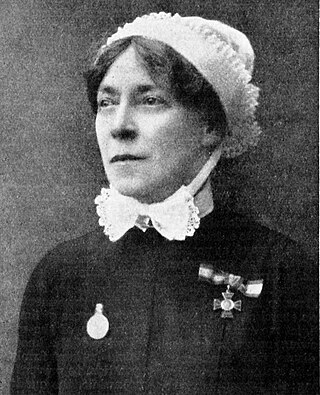
The Royal College of Nursing (RCN) is a registered trade union in the United Kingdom for those in the profession of nursing. It was founded in 1916, receiving its royal charter in 1928. Queen Elizabeth II was the patron until her death in 2022. The majority of members are registered nurses; however student nurses and healthcare assistants are also members. There is also a category of membership, at a reduced cost, for retired people.

St Bartholomew's Hospital, commonly known as Barts, is a teaching hospital located in the City of London. It was founded in 1123 and is currently run by Barts Health NHS Trust.
Myra Louise Taylor was nursing superintendent at St John's General Hospital in Newfoundland from 1916 for more than twenty years. She had been one of the first people to be educated at, and graduate from, the recently founded School of Nursing there. As superintendent she also had responsibility for the School. She had spent two years in London, England doing additional training and became a member of pioneering UK nursing organisations. During her time as superintendent at the St. John's hospital she was made a Fellow of the British College of Nurses.

The International Council of Nurses (ICN) is a federation of more than 130 national nurses associations. It was founded in 1899 and was the first international organization for health care professionals. It is headquartered in Geneva, Switzerland.

Ethel Gordon Fenwick was a British nurse who played a major role in the History of Nursing in the United Kingdom. She campaigned to procure a nationally recognised certificate for nursing, to safeguard the title "Nurse", and lobbied Parliament to pass a law to control nursing and limit it to "registered" nurses only.
Nursing in the United Kingdom has a long history. The current form of nursing is often considered as beginning with Florence Nightingale who pioneered modern nursing. Nightingale initiated formal schools of nursing in the United Kingdom in the late 19th and early 20th centuries. The role and perception of nursing has dramatically changed from that of a handmaiden to the doctor to professionals in their own right. There are over 700,000 nurses in the United Kingdom and they work in a variety of settings, such as hospitals, health centres, nursing homes, hospices, communities, and academia, with most working for the National Health Service (NHS). Nurses work across all demographics and requirements of the public: adults, children, mental health, and learning disability. Nurses work in a range of specialties from the broad areas of medicine, surgery, theatres, and investigative sciences such as imaging. Nurses also work in large areas of sub-specialities such as respiratory, diabetes, neurology, infectious diseases, liver, research, cardiac, and stoma. Nurses often work in multi-disciplinary teams but increasingly are found working independently.

The London Fever Hospital was a voluntary hospital financed from public donations in Liverpool Road in London. It was one of the first fever hospitals in the country.

Dame Alicia Frances Jane Lloyd Still, DBE, RRC, SRN (1869–1944) was a British nurse, teacher, hospital matron and leader of her profession. She was one of the leaders in the campaign for state registration of nurses. Following the Nurses Registration Act 1919, she was a member of the General Nursing Council (1920-1937). As chairwoman of the General Nursing Council's first Education and Examinations Committee she helped establish the first national examination standards for the registration of nurses.

Cromer and District Hospital opened in 1932 in the suburb of Suffield Park in the town of Cromer within the English county of Norfolk. The hospital is run by the Norfolk and Norwich University Hospitals NHS Foundation Trust and provides an important range of acute consultant and nurse-led services to the residents of the district of North Norfolk.
Dame Sarah Elizabeth Oram, became a senior member of the Army Nursing Service (ANS) and Queen Alexandra's Imperial Military Nursing Service (QAIMNS), and served as Principal Matron, Nursing Inspector in the QAIMNS, and was attached to the British Expeditionary Force, France, 1914–1915 and subsequently as Acting Matron-in-Chief, QAIMNS, Eastern Mediterranean Expeditionary Force, 1915–1919 during the First World War.

Dame Sidney Jane Browne, was the first appointed Matron-in-Chief of the newly formed Queen Alexandra's Imperial Military Nursing Service (QAIMNS). After she retired from the QAIMNS she was appointed as Matron-in-Chief of the Territorial Force Nursing Service. Browne was appointed a Dame Grand Cross of the Order of the British Empire in 1919 and, in 1922, she became the first President of the Royal College of Nursing, a post she held until 1925.
The history of nursing in the United Kingdom relates to the development of the profession since the 1850s. The history of nursing itself dates back to ancient history, when the sick were cared for in temples and places of worship. In the early Christian era, nursing in the United Kingdom was undertaken by certain women in the Christian Church, their services being extended to patients in their homes. These women had no real training by today's standards, but experience taught them valuable skills, especially in the use of herbs and folk drugs, and some gained fame as the physicians of their era. Remnants of the religious nature of nurses remains in Britain today, especially with the retention of the job title "Sister" for a senior female nurse.

Margaret Rachel Huxley (1854–1940) was an English nurse who introduced structured, scientific nursing training in Ireland. Her initiatives led to the establishment of the first nursing school in Dublin. She was involved in numerous organisations promoting professionalism in nursing and campaigning for nurse registration throughout the British Isles.

The Nurses Registration Act 1919 was an Act of Parliament of the United Kingdom.

Susan Bell McGahey was the matron of the Royal Prince Alfred Hospital from 1891 to 1904. McGahey was also co-founder of the Australasian Trained Nurses' Association in 1899 and president of the International Council of Nurses from 1904 to 1909.

The Grove Hospital, originally the Grove Fever Hospital, was a hospital for infectious diseases opened in Tooting Grove, London.

Euphemia Steele Innes RRC DN was a Scottish nurse who served for 21 years as matron at Leeds General Infirmary in Leeds, West Riding of Yorkshire, England. She was decorated with the Royal Red Cross 1st class in 1916 for services with the Territorial Force Nursing Service in the First World War.
Dora Finch, RRC, (1877–1943) was a British nurse. She served as matron of the central London teaching hospital University College Hospital for 21 years and was prominent in the development of the nursing profession in the UK.

Annie Sophia Jane McIntosh CBE, RRC was a British nurse and nursing leader. She was a Matron of St Bartholomew's Hospital, London (1910–1927), promoted the fledgling College of Nursing Ltd, and served on several wartime committees.

Margaret Elwyn Sparshott, C.B.E., R.R.C., was a British nurse. She was principal matron of Manchester Royal Infirmary, and of the Territorial Force Nursing Service at Manchester, England. During the First World War, she used 2nd Western General Hospital as a base, and had the assistance of St John Ambulance, the Voluntary Aid Detachment (VADs) and the Red Cross. Within this framework she was responsible for the running of twenty-two large auxiliary hospitals, including the field hospitals for the war wounded, in the Stockport, Salford and Manchester areas. Her duty extended to coping with increased patient numbers during the 1918–1920 flu pandemic.














